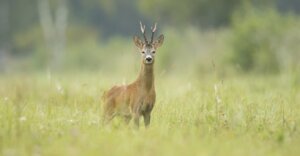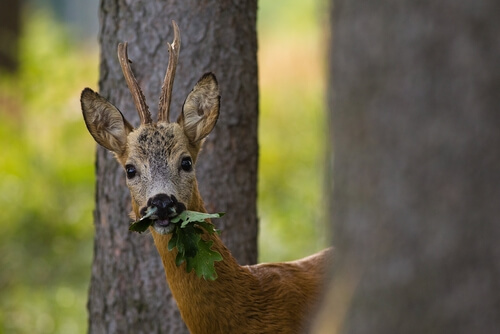The Expansion of Roe Deer in Spain


Written and verified by the biologist Miguel Mata Gallego
The roe deer (Capreolus capreolus) is an expanding species in Spain. According to data from the Spanish Roe Deer Association, its population is increasing every year. Now, although this has its positive side, it also has negative consequences.
This cervid has gone from being threatened, living in remote areas of the Iberian Peninsula, to being the cause of real havoc in farmland.
Below, we’ll tell you more about this animal, as well as the causes of this expansion, which are varied.
The spectacular expansion of the roe deer

Since the 1970s, the roe deer has gone from being an endangered species to occupying a large part of the peninsula. However, its populations are unevenly distributed. It’s abundant in the north, in the Cantabrian, Pyrenees and Iberian mountains. In the south, it is somewhat scarcer in the Montes de Toledo, Sierra Morena and the Penibetic mountain ranges.
By communities, the paradigmatic example of the expansion of this deer is Castilla y León. In this community, 21 924 were hunted in the 2017-2018 season. In Burgos alone, almost 8,000 specimens were captured and, in Soria, more than 6,000.
What is the reason for this expansion? Experts believe it is a combination of the specific biology of the species and external factors.
A species adapted to many habitats
The roe deer is a tremendously adaptive animal, and this is one of the causes of its enormous expansion. Adaptability is facilitated by the fact that its only predator is man.
It’s distributed throughout Eurasia due to the variety of habitats it has adapted to. From large cereal plains to closed forests. It’s even possible to see it in humanized areas.
The preferred habitat of the roe deer is a mixture of mixed forest and open country, where it can feed easily. These habitats are easily found in the northern half of the peninsula, even more so since rural depopulation is a fact.
Its diet consists of leaves of shrubs and low trees, as well as berries and tender shoots.
Factors explaining the expansion of the roe deer

A territorial and dispersive species
Many factors can explain the remarkable expansion of the roe deer in Spain. One of them, as forestry engineer Santiago Segovia Pérez points out, may be its notable territoriality.
Roe deer are a solitary species, unlike other mammals such as the wild boar, which are gregarious.
Young roe deer tend to separate from their mother a year after birth. This is why each specimen of Capreolus capreolus needs more territory to live in and is forced to look for new areas, thus contributing to its expansion.
Abandonment of the rural environment, a key factor
According to many authors, another factor that explains the expansion of the roe deer in Spain is the abandonment of the rural environment. Since the 1960s, many people have moved from the villages to the cities in search of work. This causes the abandonment of farmland, where the natural environment can gradually impose itself.
Therefore, there are many lands in the process of ecological succession, where scrub and some trees are beginning to grow, which are the perfect food for roe deer.
Their sex ratio
Last but not least, the sex ratio of roe deer and their particular reproductive biology has been pointed out as a key factor.
According to Laureano de las Cuevas, an expert hunter of this cervid, in some areas there are up to two roe deer for each male specimen, and this is combined with a special reproductive biology.
Females can gestate up to two roe deer per birth, since their uterus is bicornuate (it has two branches). Therefore, one of the strategies that has been implemented for some time is the hunting of female specimens to balance the sex ratio and control these populations.
The roe deer (Capreolus capreolus) is an expanding species in Spain. According to data from the Spanish Roe Deer Association, its population is increasing every year. Now, although this has its positive side, it also has negative consequences.
This cervid has gone from being threatened, living in remote areas of the Iberian Peninsula, to being the cause of real havoc in farmland.
Below, we’ll tell you more about this animal, as well as the causes of this expansion, which are varied.
The spectacular expansion of the roe deer

Since the 1970s, the roe deer has gone from being an endangered species to occupying a large part of the peninsula. However, its populations are unevenly distributed. It’s abundant in the north, in the Cantabrian, Pyrenees and Iberian mountains. In the south, it is somewhat scarcer in the Montes de Toledo, Sierra Morena and the Penibetic mountain ranges.
By communities, the paradigmatic example of the expansion of this deer is Castilla y León. In this community, 21 924 were hunted in the 2017-2018 season. In Burgos alone, almost 8,000 specimens were captured and, in Soria, more than 6,000.
What is the reason for this expansion? Experts believe it is a combination of the specific biology of the species and external factors.
A species adapted to many habitats
The roe deer is a tremendously adaptive animal, and this is one of the causes of its enormous expansion. Adaptability is facilitated by the fact that its only predator is man.
It’s distributed throughout Eurasia due to the variety of habitats it has adapted to. From large cereal plains to closed forests. It’s even possible to see it in humanized areas.
The preferred habitat of the roe deer is a mixture of mixed forest and open country, where it can feed easily. These habitats are easily found in the northern half of the peninsula, even more so since rural depopulation is a fact.
Its diet consists of leaves of shrubs and low trees, as well as berries and tender shoots.
Factors explaining the expansion of the roe deer

A territorial and dispersive species
Many factors can explain the remarkable expansion of the roe deer in Spain. One of them, as forestry engineer Santiago Segovia Pérez points out, may be its notable territoriality.
Roe deer are a solitary species, unlike other mammals such as the wild boar, which are gregarious.
Young roe deer tend to separate from their mother a year after birth. This is why each specimen of Capreolus capreolus needs more territory to live in and is forced to look for new areas, thus contributing to its expansion.
Abandonment of the rural environment, a key factor
According to many authors, another factor that explains the expansion of the roe deer in Spain is the abandonment of the rural environment. Since the 1960s, many people have moved from the villages to the cities in search of work. This causes the abandonment of farmland, where the natural environment can gradually impose itself.
Therefore, there are many lands in the process of ecological succession, where scrub and some trees are beginning to grow, which are the perfect food for roe deer.
Their sex ratio
Last but not least, the sex ratio of roe deer and their particular reproductive biology has been pointed out as a key factor.
According to Laureano de las Cuevas, an expert hunter of this cervid, in some areas there are up to two roe deer for each male specimen, and this is combined with a special reproductive biology.
Females can gestate up to two roe deer per birth, since their uterus is bicornuate (it has two branches). Therefore, one of the strategies that has been implemented for some time is the hunting of female specimens to balance the sex ratio and control these populations.
All cited sources were thoroughly reviewed by our team to ensure their quality, reliability, currency, and validity. The bibliography of this article was considered reliable and of academic or scientific accuracy.
- Boyle, K.V. 2006. Neolithic wild game animals in Western Europe: The question of hunting, pp 10 – 23. In Animals in the Neolithic of Britain and Europe, Serjeantson, D, and Field, D (eds). Oxbow Books: Oxford.
- Lovari, S., Herrero, J., Masseti, M., Ambarli, H., Lorenzini, R. & Giannatos, G. 2016. Capreolus capreolus. The IUCN Red List of Threatened Species 2016: e.T42395A22161386. http://dx.doi.org/10.2305/IUCN.UK.2016-1.RLTS.T42395A22161386.en. Downloaded on 24 June 2019
-
Cabrera A. Fauna ibérica; mamíferos [Internet]. Madrid, Museo Nacional de Ciencias Naturales; 1914 [citado 24 de junio de 2019]. 528 p.
This text is provided for informational purposes only and does not replace consultation with a professional. If in doubt, consult your specialist.








